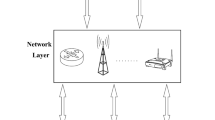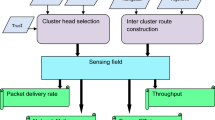Abstract
Wireless sensor network (WSN) based applications have become regular in our daily lives, and their integration with the Internet of Things (IoT) makes them even more productive and convenient. However, the inclusion of massive devices, which form the core of IoT, raises plenty of security concerns. Many security strategies to handle data privacy have been proposed in previous work. However, very few of these schemes addressed the confidentiality of the sensor node's position. The goal of this study is to ensure source node location privacy by source location privacy preservation technique by randomized ring routing and confounding transmission (SLP-RRRCT). Random routing with confusing transmission benefits the SLP-RRRCT by distracting the adversary backtracking process. After the random routing phase expires, packets are forwarded to the base station (BS) by neighbour grid-based ring routing. During the development of SLP-RRRCT, we concentrated on the privacy of sensor node position, sensor energy usage, network lifetime, and packet routing randomization. Through a simulation experiment and theoretical analysis, we have observed that the proposed SLP-RRRCT provides better safety time, randomization in transmission delay, and large network lifetime than the compared techniques, i.e., baseline, probabilistic, phantom, source location protection protocol based on dynamic routing (SLPDR), and source location privacy protection scheme based on ring-loop routing (SLPRR).

























Similar content being viewed by others
References
Jhumka, A., Bradbury, M., Leeke, M. (2012). Towards understanding source location privacy in wireless sensor networks through fake sources. In Proc. of the 11th IEEE Int. conference on trust, security and privacy in computing and communications, TrustCom-2012 - 11th IEEE Int. conference on ubiquitous computing and communications, IUCC-2012 (pp. 760–768).
Mutalemwa, L.C., Shin, S. (2019). Achieving source location privacy protection in monitoring wireless sensor networks through proxy node routing. Sensors (Switzerland), vol. 19. https://doi.org/10.3390/s19051037.
Mousavi, S. K., Ghaffari, A., Besharat, S., & Afshari, H. (2021). Security of internet of things based on cryptographic algorithms: A survey. Wireless Networks, 27, 1515–1555. https://doi.org/10.1007/s11276-020-02535-5
Shukla, A. S., & Tripathi, S. (2019). A matrix-based pair-wise key establishment for secure and energy efficient WSN-assisted IoT. International Journal of Information Security and Privacy, 13, 91–105. https://doi.org/10.4018/ijisp.201907010106
Vieira, R. G., da Cunha, A. M., & de Camargo, A. P. (2015). An energy management method of sensor nodes for environmental monitoring in Amazonian Basin. Wireless Networks, 21, 793–807. https://doi.org/10.1007/s11276-014-0815-x
Jain, V.R., Bagree, R., Kumar, A., Ranjan, P. (2008). wildCENSE: GPS based animal tracking system. In ISSNIP 2008 - Proceedings of the 2008 international conference on intelligent sensors, sensor networks and information processing (pp. 617–622).
Mainwaring, A., Culler, D., Polastre, J., Szewczyk, R., Anderson, J. (2002). Wireless sensor networks for habitat monitoring. In Proceedings of the 1st ACM international workshop on Wireless sensor networks and applications - WSNA ’02 (p 88) Association for Computing Machinery (ACM), New York, New York, USA.
Bagree, R., Jain, V.R., Kumar, A., Ranjan, P. (2010). TigerCENSE: Wireless image sensor network to monitor tiger movement. In Lecture notes in computer science (including subseries lecture notes in artificial intelligence and lecture notes in bioinformatics) (pp. 13–24). Springer, Berlin, Heidelberg.
Raja, M., & Datta, R. (2018). An enhanced source location privacy protection technique for wireless sensor networks using randomized routes. IETE Journal of Research, 64, 764–776. https://doi.org/10.1080/03772063.2017.1371652
Tan, R., Tao, Y., Si, W., & Zhang, Y. Y. (2020). Privacy preserving semantic trajectory data publishing for mobile location-based services. Wireless Networks, 26, 5551–5560. https://doi.org/10.1007/s11276-019-02058-8
Guleria, K., Verma, A.K. (2019). Comprehensive review for energy efficient hierarchical routing protocols on wireless sensor networks. https://doi.org/10.1007/s11276-018-1696-1.
Shukla, A., Tripathi, S. (2019). Analysis of energy efficient framework for static and mobile nodes in WSN-Assisted IoT. In Communications in computer and information science (pp. 269–280). Springer.
Somasundaram, R., & Thirugnanam, M. (2020). Review of security challenges in healthcare internet of things. Wireless Networks. https://doi.org/10.1007/s11276-020-02340-0
Ozturk, C., Zhang, Y., Trappe, W. (2004). Source-location privacy in energy-constrained sensor network routing. In Proceedings of the 2004 ACM Workshop on Security of Ad Hoc and Sensor Networks, SASN’04 (pp. 88–93). Association for Computing Machinery.
Kamat, P., Zhang, Y., Trappe, W., Ozturk, C. (2005). Enhancing source-location privacy in sensor network routing. In 25th IEEE international conference on distributed computing systems (ICDCS’05) (pp. 599–608). IEEE.
Wang, H., Han, G., Zhou, L., Ansere, J. A., & Zhang, W. (2019). A source location privacy protection scheme based on ring-loop routing for the IoT. Computer Networks, 148, 142–150. https://doi.org/10.1016/j.comnet.2018.11.005
Han, G., Zhou, L., Wang, H., Zhang, W., & Chan, S. (2017). A source location protection protocol based on dynamic routing in WSNs for the social Internet of Things. Future Generation Computer Systems. https://doi.org/10.1016/j.future.2017.08.044
Jhumka, A., Bradbury, M. (2017). Deconstructing source location privacy-aware routing protocols. In Proc. Symp. Appl. Comput. - SAC ’17 (pp. 431–436). https://doi.org/10.1145/3019612.3019655.
Comput, J. P. D., Long, J., Liu, A., Dong, M., & Li, Z. (2015). An energy-efficient and sink-location privacy enhanced scheme for WSNs through ring based routing. Journal of Parallel and Distributed Computing, 81–82, 47–65. https://doi.org/10.1016/j.jpdc.2015.04.003
Chen, J., Lin, Z., Hu, Y., & Wang, B. (2015). Hiding the source based on limited flooding for sensor networks. Sensors (Switzerland)., 15, 29129–29148. https://doi.org/10.3390/s151129129
Sheu, J.P., Jiang, J.R., Tu, C. (2008). Anonymous path routing in wireless sensor networks. In IEEE international conference on communications (pp. 2728–2734).
Rashwan, A. M., Taha, A.-E.M., & Hassanein, H. S. (2014). Characterizing the performance of security functions in mobile computing systems. IEEE Internet of Things Journal, 1, 399–413. https://doi.org/10.1109/JIOT.2014.2360217
Manjula, R., & Datta, R. (2018). A novel source location privacy preservation technique to achieve enhanced privacy and network lifetime in WSNs. Pervasive and Mobile Computing, 44, 58–73. https://doi.org/10.1016/j.pmcj.2018.01.006
Jan, M. A., Nanda, P., He, X., & Liu, R. P. (2018). A Sybil attack detection scheme for a forest wildfire monitoring application. Future Generation Computer Systems, 80, 613–626. https://doi.org/10.1016/j.future.2016.05.034
Thirukrishna, J. T., Karthik, S., & Arunachalam, V. P. (2018). Revamp energy efficiency in homogeneous wireless sensor networks using optimized radio energy algorithm (OREA) and Power-aware distance source routing protocol. Future Generation Computer Systems, 81, 331–339. https://doi.org/10.1016/j.future.2017.11.042
Shukla, A., & Tripathi, S. (2018). An optimal relay node selection technique to support green internet of things. Journal of Intelligent & Fuzzy Systems, 35, 1301–1314. https://doi.org/10.3233/JIFS-169674
Deng, J., Han, R., & Mishra, S. (2006). Decorrelating wireless sensor network traffic to inhibit traffic analysis attacks. Pervasive and Mobile Computing, 2, 159–186. https://doi.org/10.1016/j.pmcj.2005.12.003
Shukla, A., & Tripathi, S. (2020). A multi-tier based clustering framework for scalable and energy efficient WSN-assisted IoT network. Wireless Networks, 26, 3471–3493. https://doi.org/10.1007/s11276-020-02277-4
Author information
Authors and Affiliations
Corresponding authors
Ethics declarations
Conflict of interest
On behalf of all authors, the corresponding author states that there is no conflict of interest.
Additional information
Publisher's Note
Springer Nature remains neutral with regard to jurisdictional claims in published maps and institutional affiliations.
Rights and permissions
About this article
Cite this article
Shukla, A., Singh, D., Sajwan, M. et al. A source location privacy preservation scheme in WSN-assisted IoT network by randomized ring and confounding transmission. Wireless Netw 28, 827–852 (2022). https://doi.org/10.1007/s11276-021-02876-9
Accepted:
Published:
Issue Date:
DOI: https://doi.org/10.1007/s11276-021-02876-9




